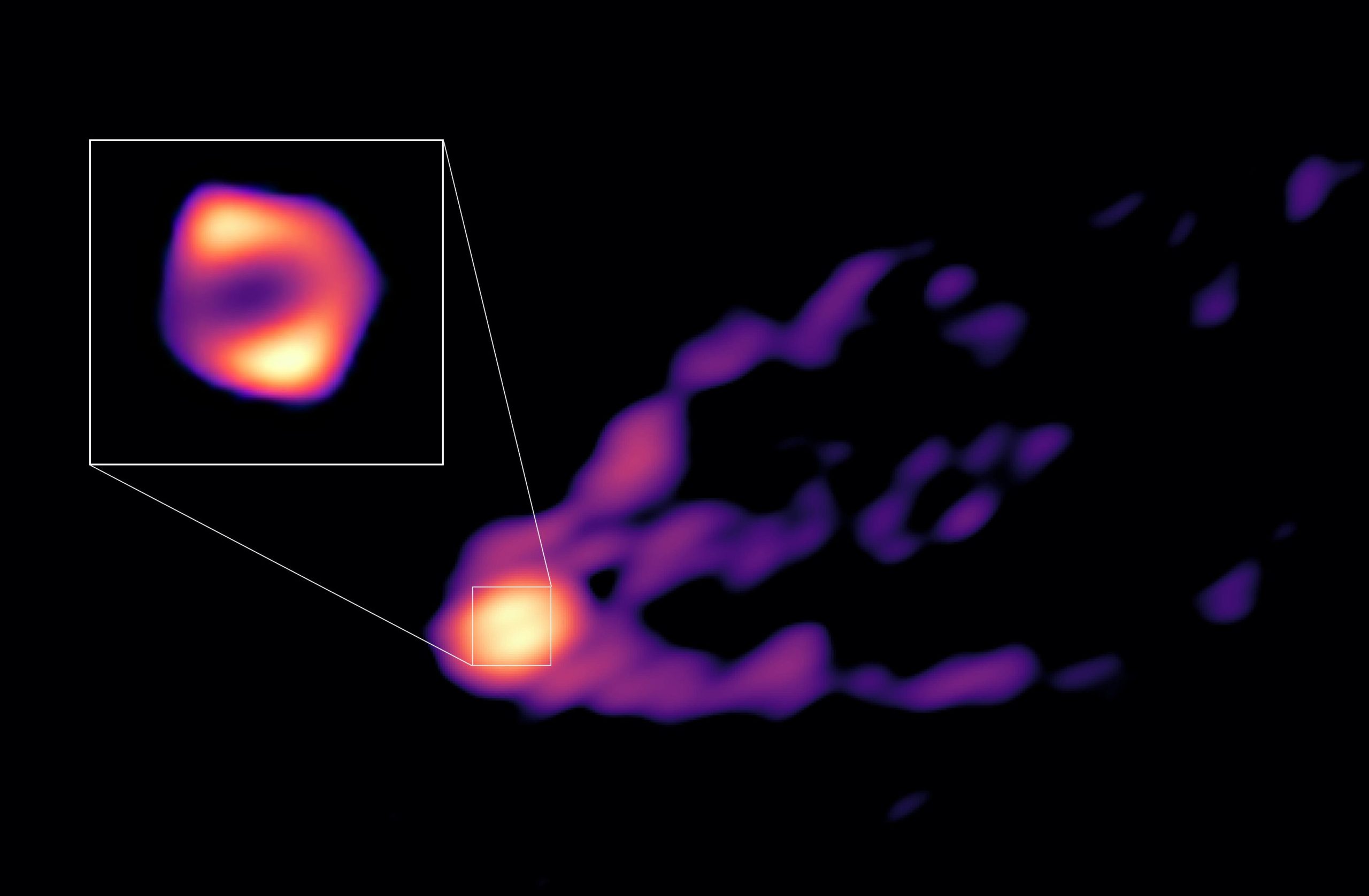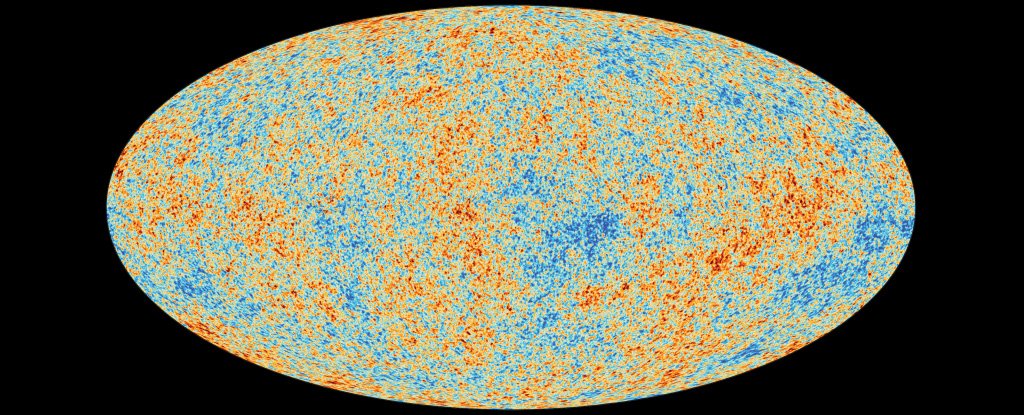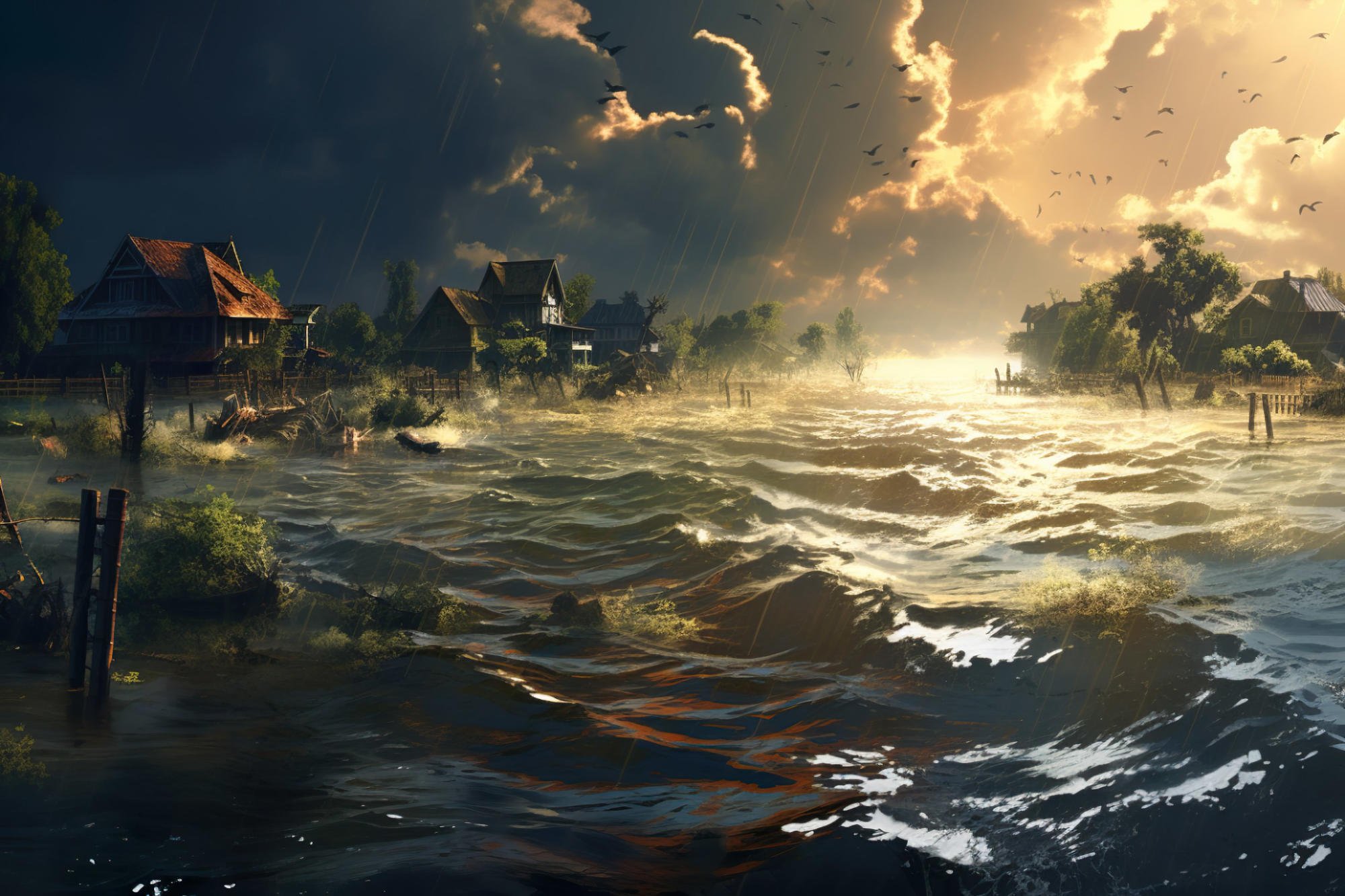Bezprecedentný obraz silného výtrysku a tieňa čiernej diery zachytený astronómami

Vedci použili pozorovania na milimetrových vlnových dĺžkach na vytvorenie bezprecedentného obrazu, ktorý zobrazuje hmotu padajúcu do centrálnej čiernej diery a silný relativistický výtrysk galaxie Messier 87. Spolupráca rôznych teleskopov zlepšila zobrazovacie schopnosti, aby pomohla vizualizovať spojenie medzi akrečným tokom čiernej diery a pôvodom výtrysku. Okrem toho objavili v blízkosti čiernej diery neočakávane rozšírenú radiáciu, čo naznačuje väčšiu aktivitu. Poďakovanie: S. Dagnello (NRAO/AUI/NSF)
milimetrový-VLBI obraz prúdnice a[{“ attribute=““>black hole shadow in Messier 87, obtained with the GMVA array including ALMA, the Greenland Telescope, and the telescope at Metsähovi.
An international team of scientists, including Aalto University researchers, has used new millimeter-wavelength observations to produce an image that shows, for the first time, both the ring-like structure that reveals the matter falling into the central black hole and the powerful relativistic jet in the prominent radio galaxy Messier 87. The image underlines for the first time the connection between the accretion flow near the central supermassive black hole and the origin of the jet. The new observations were obtained with the Global Millimetre VLBI Array (GMVA), complemented by the phased Atacama Large Millimeter/submillimeter Array (ALMA) and the Greenland Telescope (GLT). The addition of these two observatories has greatly enhanced the imaging capabilities of the GMVA. The results were published in the journal Nature.
“Previously, we had seen both the black hole and the jet in separate images, but now we have taken a panoramic picture of the black hole together with its jet at a new wavelength,” says Ru-Sen Lu of the Shanghai Astronomical Observatory, who also leads a Max Planck Research Group at the Chinese Academy of Sciences.

This image shows the jet and shadow of the black hole at the center of the M87 galaxy together for the first time. This image gives scientists the context needed to understand how the powerful jet is formed. The new observations also revealed that the black hole’s ring, shown here in the inset, is 50% larger than the ring observed at shorter radio wavelengths by the Event Horizon Telescope (EHT). This suggests that in the new image, we see more of the material that is falling toward the black hole than what we could see with the EHT. Credit: R.-S. Lu (SHAO), E. Ros (MPIfR), S. Dagnello (NRAO/AUI/NSF)
The surrounding material is thought to fall into the black hole in a process known as accretion, but no one has ever imaged it directly. “The ring that we have seen before is becoming larger and thicker at 3.5 mm observing wavelength. This shows that the material falling into the black hole produces additional emission that is now observed in the new image. This gives us a more complete view of the physical processes acting near the black hole,” he added.
The participation of ALMA and GLT in the GMVA observations and the resulting increase in resolution and sensitivity of this intercontinental network of telescopes has made it possible to image the ring-like structure in M87 for the first time at a wavelength of 3.5 mm. The diameter of the ring measured by the GMVA is 64 microarcseconds, which corresponds to the size of a small (5-inch/13-cm) selfie ring light as seen by an astronaut on the Moon looking back at Earth. This diameter is 50 percent larger than what was seen in observations by the Event Horizon Telescope at 1.3 mm, in accordance with the expectations for the emission from relativistic plasma in this region.
“With the greatly improved imaging capabilities from adding ALMA and GLT into GMVA observations, we have gained a new perspective. We do indeed see the triple-ridged jet that we knew about from earlier VLBI observations,” says Thomas Krichbaum from the Max Planck Institute for Radio Astronomy (MPIfR) in Bonn. “But now we can see how the jet emerges from the emission ring around the central supermassive black hole and we can measure the ring diameter also at another (longer) wavelength.”
14-metrový rádioteleskop na Aalto University Metsahovy Radio Observatory bol jednou zo staníc, ktoré zbierali dáta pre nový obrázok.
Tuomas Savolainen, vedúci vedec na univerzite Aalto a spoluautor článku, hovorí, že rádiové observatórium Metsähövi sa zúčastňuje na kampaniach merania GMVA už viac ako desať rokov a vo všeobecnosti na pozorovaniach 3,5 mm VLBI od polovice 90. rokov minulého storočia. ,
„Náš rádioteleskop v Metšahovy bol jednou z iba piatich staníc v Európe, ktoré sa v roku 2018 zúčastnili na týchto pozorovaniach. Antény schopné robiť merania na vlnovej dĺžke 3,5 mm nie sú až také veľké, a preto sú údaje zozbierané v Metšahovach cenné,“ uvádzajú. .
„Snímka Event Horizon Telescope ukazuje tieň čiernej diery v M87, ale kvôli malému počtu ďalekohľadov pri týchto pozorovaniach sme neboli schopní detekovať slabší a predĺžený výtrysk. 1,3 mm vlna v porovnaní s ďalekohľadom pozorujúcim na 3,5 mm.“ Existuje ešte menej ďalekohľadov schopných vykonávať pozorovania pri tejto vlnovej dĺžke, “ hovorí Savolainen.
Svetlo z M87 je produkované interakciami medzi vysoko energetickými elektrónmi a magnetickými poľami, jav známy ako synchrotrónové žiarenie. Nové pozorovania pri vlnovej dĺžke 3,5 mm odhaľujú viac informácií o umiestnení a energii týchto elektrónov.
S pomocou ALMA astronómovia získali nový obraz supermasívnej čiernej diery v strede galaxie M87. Kredit:[{“ attribute=““>ESO
They also tell us something about the nature of the black hole itself: it is not very hungry. It consumes matter at a low rate, converting only a small fraction of it into radiation. Keiichi Asada of the Academia Sinica Institute of Astronomy and Astrophysics explains: “To understand the physical origin of the bigger and thicker ring, we had to use computer simulations to test different scenarios. As a result, we concluded that the larger extent of the ring is associated with the accretion flow.”
Kazuhiro Hada from the National Astronomical Observatory of Japan adds: “We also find something surprising in our data: the radiation from the inner region close to the black hole is broader than we expected. This could mean that there is more than just gas falling in. There could also be a wind blowing out, causing turbulence and chaos around the black hole.”
The quest to learn more about Messier 87 is not over, as further observations and a fleet of powerful telescopes continue to unlock its secrets. “Future observations at millimeter wavelengths will study the time evolution of the M87 black hole and provide a poly-chromatic view of the black hole with multiple color images in radio light,” says Jongho Park of the Korea Astronomy and Space Science Institute.
Some of these new observations are taking place this spring, and the Metsähovi Radio Observatory is again taking part in them.
“3.5 mm is the shortest wavelength at which we operate at the moment, and those observations require good, dry weather conditions. Luckily, the weather in April is often good here. In a couple of years, we will get a new receiver for our telescope that will allow making observations simultaneously over a wide range of wavelengths. Then we will be able to better correct for the distortions in data caused by the atmosphere and obtain even higher quality images,” says Petri Kirves, Metsähovi Radio Observatory Operations Engineer.
For more on this discovery:
Reference: “A ring-like accretion structure in M87 connecting its black hole and jet” by Ru-Sen Lu, Keiichi Asada, Thomas P. Krichbaum, Jongho Park, Fumie Tazaki, Hung-Yi Pu, Masanori Nakamura, Andrei Lobanov, Kazuhiro Hada, Kazunori Akiyama, Jae-Young Kim, Ivan Marti-Vidal, José L. Gómez, Tomohisa Kawashima, Feng Yuan, Eduardo Ros, Walter Alef, Silke Britzen, Michael Bremer, Avery E. Broderick, Akihiro Doi, Gabriele Giovannini, Marcello Giroletti, Paul T. P. Ho, Mareki Honma, David H. Hughes, Makoto Inoue, Wu Jiang, Motoki Kino, Shoko Koyama, Michael Lindqvist, Jun Liu, Alan P. Marscher, Satoki Matsushita, Hiroshi Nagai, Helge Rottmann, Tuomas Savolainen, Karl-Friedrich Schuster, Zhi-Qiang Shen, Pablo de Vicente, R. Craig Walker, Hai Yang, J. Anton Zensus, Juan Carlos Algaba, Alexander Allardi, Uwe Bach, Ryan Berthold, Dan Bintley, Do-Young Byun, Carolina Casadio, Shu-Hao Chang, Chih-Cheng Chang, Song-Chu Chang, Chung-Chen Chen, Ming-Tang Chen, Ryan Chilson, Tim C. Chuter, John Conway, Geoffrey B. Crew, Jessica T. Dempsey, Sven Dornbusch, Aaron Faber, Per Friberg, Javier González García, Miguel Gómez Garrido, Chih-Chiang Han, Kuo-Chang Han, Yutaka Hasegawa, Ruben Herrero-Illana, Yau-De Huang, Chih-Wei L. Huang, Violette Impellizzeri, Homin Jiang, Hao Jinchi, Taehyun Jung, Juha Kallunki, Petri Kirves, Kimihiro Kimura, Jun Yi Koay, Patrick M. Koch, Carsten Kramer, Alex Kraus, Derek Kubo, Cheng-Yu Kuo, Chao-Te Li, Lupin Chun-Che Lin, Ching-Tang Liu, Kuan-Yu Liu, Wen-Ping Lo, Li-Ming Lu, Nicholas MacDonald, Pierre Martin-Cocher, Hugo Messias, Zheng Meyer-Zhao, Anthony Minter, Dhanya G. Nair, Hiroaki Nishioka, Timothy J. Norton, George Nystrom, Hideo Ogawa, Peter Oshiro, Nimesh A. Patel, Ue-Li Pen, Yurii Pidopryhora, Nicolas Pradel, Philippe A. Raffin, Ramprasad Rao, Ignacio Ruiz, Salvador Sanchez, Paul Shaw, William Snow, T. K. Sridharan, Ranjani Srinivasan, Belén Tercero, Pablo Torne, Efthalia Traianou, Jan Wagner, Craig Walther, Ta-Shun Wei, Jun Yang and Chen-Yu Yu, 26 April 2023, Nature.
DOI: 10.1038/s41586-023-05843-w

Web nerd. Organizátor extrémov. Spisovateľ. Evanjelista celkom potravín. Certifikovaný introvert.





